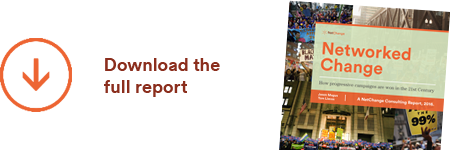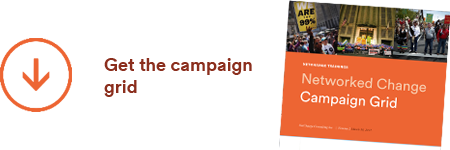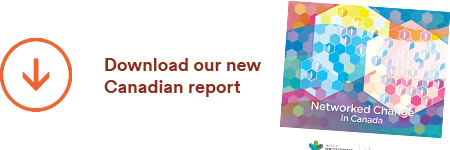This week’s Canadian election was shaping up as a once in a generation game-changer. Some surprisingly creative social media campaigns – driven by a few smart new players – were making an impact on the nightly news and with large swaths of voters, especially youth. I decided to reach out to the leaders of these groups to see if we could find ways to increase their impact.
The pitch was to collaborate publicly and behind the scenes to show up as a united and organized movement. 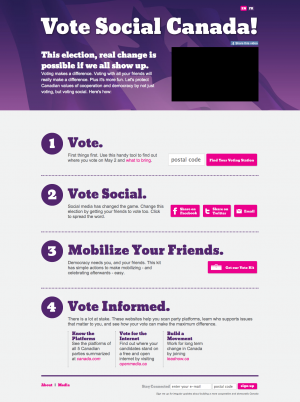 And to create a powerful content network through shared key messaging and activities that would drive more traffic to everyone’s sites and, most importantly, the voting booth.
And to create a powerful content network through shared key messaging and activities that would drive more traffic to everyone’s sites and, most importantly, the voting booth.
Near the end of our first call, an idea emerged: if someone created a one page voting site, helping (especially new) people to vote and tell their friends about it, with light, non-partisan and positive messaging, everyone would get behind it. So, working with an amazing team of volunteers, we came up with joint messaging – “protecting democracy and cooperation” – built a website – VoteSocial.ca – and pushed it through our networks.
What happened next will be debated by bigger minds than mine, but for what we set out to do I think we pulled off some magic. Engagement from the partners was unlike anything I’ve seen. We quickly implemented the joint messaging, linking to each other and to VoteSocial.ca. The newly famous ShitHarperDid.ca folks mentioned it on CTV news. OpenMedia.ca messaged their 500K supporters, twice, about our call to action and in other media like this CBS.com article. Avaaz.org pushed ProjectDemocracy as their primary action to their 500K supporters. LeadNow promoted the idea as its main message for the entire final week.
By 10 AM Canada had already surpassed its typical volume of tweets on an election day. The traffic to ProjectDemocracy hit over 1M pageviews. The VoteSocial message was RT’d many thousands of times by supporters, celebrities like Margaret Atwood (170K followers), and even NGO’s and businesses who typically stay out of politics. 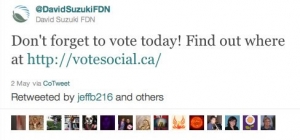 In the end voter turnout was up 3%, reversing a seven year trend.
In the end voter turnout was up 3%, reversing a seven year trend.
Did we cause all this to happen? Of course not. Did we help grow the wave that was already cresting? Yep. Do we have an emerging plan to convert those “weak tie” supporters into community leaders engaged in movement building over the long-haul? You betcha.
And driving big traffic to our site was never our goal. The focus on that outdated me-centric metric is actually what kills most coalitions. We wanted the content and engagement, not our brand, to spread in a distributed fashion. All of that was achieved, in spades.
What worked? I pulled out these four principles:

Convene the right people and listen. The group we called together were not only successful, but open, humble, are in the game to build movements not just their own power (don’t all NGO’s start out that way?). We listened to each partner’s plans, exploring ways of filling in gaps and adding value to existing work. When a good idea emerged, we questioned relentlessly whether it was truly useful and needed. It was only when we saw momentum grow quickly around it we knew it was the right action to take.

Build network principles into the core. Our simple strategy was designed for easy sharing by partners and their networks, individuals and other unaligned 3rd parties, using the only two social networks that matter. The actions, based on an Engagement Pyramid model, didn’t overwhelm people with options, starting with the easiest and most important ask first (Vote!) before we invited them to do more. Mostly we just wanted people to vote and tell their friends, we didn’t care if they used our site to do it or not.

Engage partners meaningfully. I worked hard to ensure partners “got” how core this was to their own strategy, and secured tangible commitments to promoting the site before we built it. We managed which brands were ultimately public and which couldn’t be to keep everyone at the table. This was the hard work of coalition building but because of #1 people were honest and direct so we could surface the real issues blocking collaboration, deal with them and move on.

Protect simplicity from scope creep. The website was designed to do 1 thing and that thing only. It was useful, providing an actual service people needed (find your voting station). We usability tested it. We resisted the temptation (or pressure) to add more features or calls to action. Notice we didn’t build yet another Facebook group?
It was rewarding to apply what I learned at the TckTckTck climate campaign here. One of the most powerful things we did in the lead up to Copenhagen was create a common message. Nearly every partner – as well as the media and leaders like British PM Gordon Brown – used our “fair, ambitious, and binding agreement” language as the yardstick for a deal. The simplicity upset the policy folks, but it’s how we kept a diverse coalition together, and broke through with one message.
With TckTckTck we also found how much easier – and faster – it is to collaborate among digital leaders. It’s baked into the DNA of most non-profit communications departments to always promote their own org’s work, basically exclusively. Most of their supporters joined because they care about an issue, not just one brand’s approach to it. When NGO’s work alone, they miss the opportunity to share the good work of others, and in our interconnected world they risk becoming less and less relevant. Digital people (and “networked orgs” born after the Internet) get this disconnect and are much more likely to collaborate in seemingly risky ways.
This story shows again that a web campaign isn’t at all about a website. Our success reflects an organizational model of open collaboration that works in a networked world. I’m sure there’s lots we could have done better, but given what we could control, we can all head off to the benches for a break now knowing we didn’t leave anything on the ice. Because next time we have to skate even harder.






